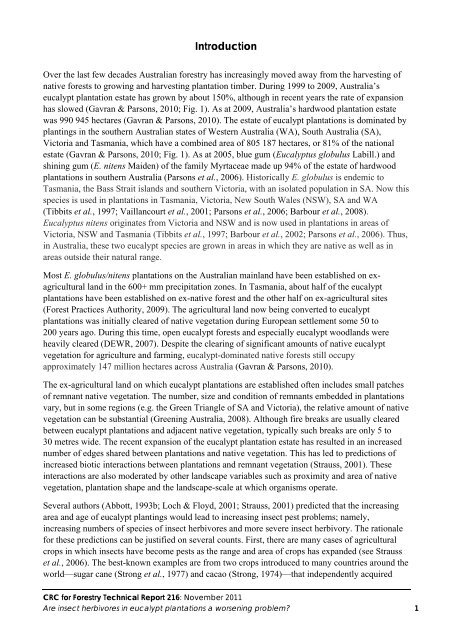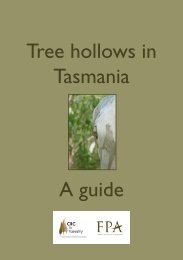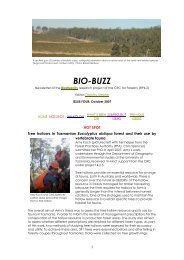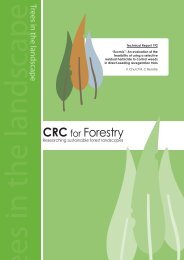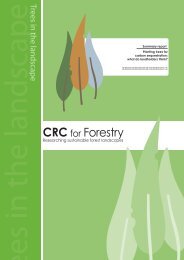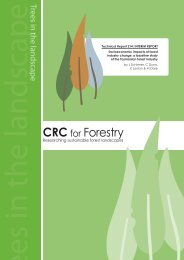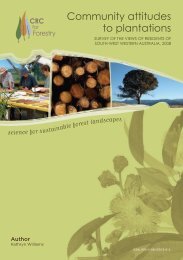CRC Forestry - CRC for Forestry
CRC Forestry - CRC for Forestry
CRC Forestry - CRC for Forestry
You also want an ePaper? Increase the reach of your titles
YUMPU automatically turns print PDFs into web optimized ePapers that Google loves.
Introduction<br />
Over the last few decades Australian <strong>for</strong>estry has increasingly moved away from the harvesting of<br />
native <strong>for</strong>ests to growing and harvesting plantation timber. During 1999 to 2009, Australia’s<br />
eucalypt plantation estate has grown by about 150%, although in recent years the rate of expansion<br />
has slowed (Gavran & Parsons, 2010; Fig. 1). As at 2009, Australia’s hardwood plantation estate<br />
was 990 945 hectares (Gavran & Parsons, 2010). The estate of eucalypt plantations is dominated by<br />
plantings in the southern Australian states of Western Australia (WA), South Australia (SA),<br />
Victoria and Tasmania, which have a combined area of 805 187 hectares, or 81% of the national<br />
estate (Gavran & Parsons, 2010; Fig. 1). As at 2005, blue gum (Eucalyptus globulus Labill.) and<br />
shining gum (E. nitens Maiden) of the family Myrtaceae made up 94% of the estate of hardwood<br />
plantations in southern Australia (Parsons et al., 2006). Historically E. globulus is endemic to<br />
Tasmania, the Bass Strait islands and southern Victoria, with an isolated population in SA. Now this<br />
species is used in plantations in Tasmania, Victoria, New South Wales (NSW), SA and WA<br />
(Tibbits et al., 1997; Vaillancourt et al., 2001; Parsons et al., 2006; Barbour et al., 2008).<br />
Eucalyptus nitens originates from Victoria and NSW and is now used in plantations in areas of<br />
Victoria, NSW and Tasmania (Tibbits et al., 1997; Barbour et al., 2002; Parsons et al., 2006). Thus,<br />
in Australia, these two eucalypt species are grown in areas in which they are native as well as in<br />
areas outside their natural range.<br />
Most E. globulus/nitens plantations on the Australian mainland have been established on ex-<br />
agricultural land in the 600+ mm precipitation zones. In Tasmania, about half of the eucalypt<br />
plantations have been established on ex-native <strong>for</strong>est and the other half on ex-agricultural sites<br />
(Forest Practices Authority, 2009). The agricultural land now being converted to eucalypt<br />
plantations was initially cleared of native vegetation during European settlement some 50 to<br />
200 years ago. During this time, open eucalypt <strong>for</strong>ests and especially eucalypt woodlands were<br />
heavily cleared (DEWR, 2007). Despite the clearing of significant amounts of native eucalypt<br />
vegetation <strong>for</strong> agriculture and farming, eucalypt-dominated native <strong>for</strong>ests still occupy<br />
approximately 147 million hectares across Australia (Gavran & Parsons, 2010).<br />
The ex-agricultural land on which eucalypt plantations are established often includes small patches<br />
of remnant native vegetation. The number, size and condition of remnants embedded in plantations<br />
vary, but in some regions (e.g. the Green Triangle of SA and Victoria), the relative amount of native<br />
vegetation can be substantial (Greening Australia, 2008). Although fire breaks are usually cleared<br />
between eucalypt plantations and adjacent native vegetation, typically such breaks are only 5 to<br />
30 metres wide. The recent expansion of the eucalypt plantation estate has resulted in an increased<br />
number of edges shared between plantations and native vegetation. This has led to predictions of<br />
increased biotic interactions between plantations and remnant vegetation (Strauss, 2001). These<br />
interactions are also moderated by other landscape variables such as proximity and area of native<br />
vegetation, plantation shape and the landscape-scale at which organisms operate.<br />
Several authors (Abbott, 1993b; Loch & Floyd, 2001; Strauss, 2001) predicted that the increasing<br />
area and age of eucalypt plantings would lead to increasing insect pest problems; namely,<br />
increasing numbers of species of insect herbivores and more severe insect herbivory. The rationale<br />
<strong>for</strong> these predictions can be justified on several counts. First, there are many cases of agricultural<br />
crops in which insects have become pests as the range and area of crops has expanded (see Strauss<br />
et al., 2006). The best-known examples are from two crops introduced to many countries around the<br />
world—sugar cane (Strong et al., 1977) and cacao (Strong, 1974)—that independently acquired<br />
<strong>CRC</strong> <strong>for</strong> <strong>Forestry</strong> Technical Report 216: November 2011<br />
Are insect herbivores in eucalypt plantations a worsening problem? 1


